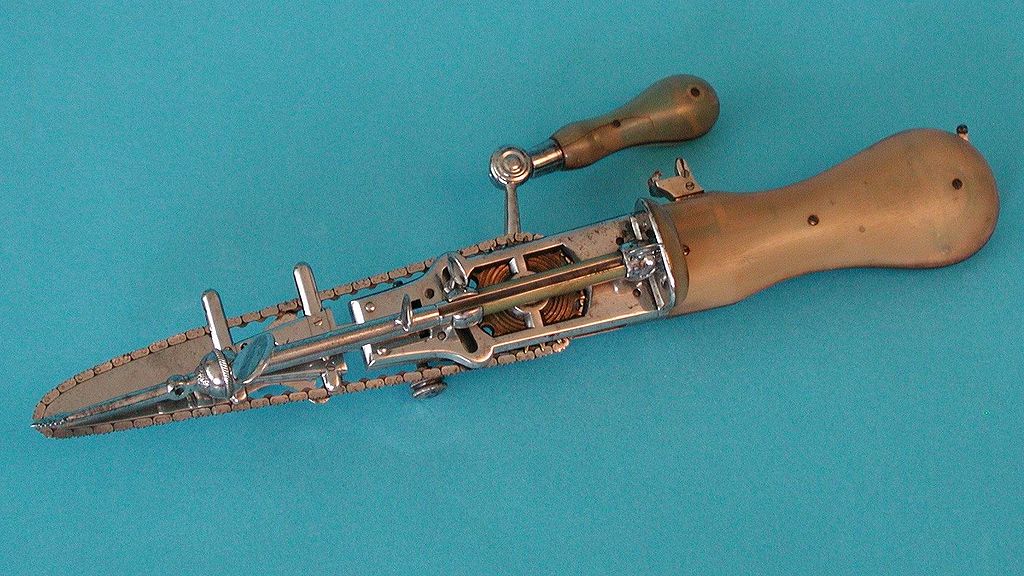Chainsaws come with a specific image of a lumberjack mowing down a tree, or of Leatherface from Texas Chainsaw Massacre. These days, chainsaws are seen as large, powerful, and even violent. So people are horrified to learn of their original purpose. Chainsaws were invented in the 18th century by two Scottish surgeons, John Aitken and James Jeffray, and they created the tool to saw through human flesh and bone during difficult childbirths. [1]
The History of Childbirth and C-Sections
Childbirth is far from a comfortable experience, even today. But this was back in the 1700s, before the invention of anesthesia and other tools that might make the process less painful. A delivery could become life-threatening very quickly, and doctors and surgeons didn’t have modern advancements to save infants and mothers during complicated births. Cesarean sections were rare, and for good reason.
The first written record of a successful C-section came from Switzerland in the 1500s. A professional cow castrator performed the procedure on his wife. A report of the account written 82 years later claimed the mother and child survived, with the child living until the ripe old age of 77, although this report was disputed by some historians.
Meanwhile, the first record of a C-section in the United States sounds like something out of a horror story. Dr. John L. Richmond wrote the account in the 1830 edition of the Western Journal of Medical and Physical Sciences. The case involved a complicated birth during a storm, with labor stalling for many hours. Richmond believed the mother’s life was at risk, and “feeling a deep and solemn sense of my responsibility, with only a case of common pocket instruments, about one o’clock that night, I commenced the Cesarean Section.”
He used a blade from a pair of crooked scissors to try to remove the fetus but “as it was uncommonly large, and the mother very fat, and having no assistance, I found this part of my operation more difficult than I had anticipated.” The mother was in excruciating pain and he decided that “a childless mother was better than a motherless child” and focused on removing the fetus and saving the mother. This account shows the peril of this procedure before antiseptics and anesthetics, and why C-sections were rare before the late 1900s. [2]
Read: Mystery of Woman Who Vanished After Going to the ER Finally Solved 32 Years Later
The Original Chainsaw
Without cesarean sections, all babies had to pass through the birth canal, calling for extreme and unfortunate procedures that left mothers with life-long complications. For complicated cases, like a baby stuck in the canal, doctors had to cut into the bone and cartilage of the pubic symphysis joint to widen the pelvic area. Time was often of the essence since the patient could go into shock or contract a lethal infection. The mother was awake this whole time.

Now, Aitken and Jeffray found that a sharp blade didn’t cut through bone fast enough to guarantee the baby’s survival. So they created a chainsaw for a faster, cleaner, and more precise cut. Keep in mind, the original chainsaw was about as big as a kitchen knife and operated by a hand crank. So not as scary as the variations today. Still, it’s hard to think of a hand-powered crank chainsaw as a vast improvement, but it was. And remember, mothers were typically awake throughout all of this.
This procedure became known as a symphysiotomy and is thankfully outdated. Symphysiotomy became less frequent in the late 20th century as the cesarean section became a safer option after thorough improvement in techniques, hygiene, and medical practices. Chainsaws no longer have any place in surgical wards, although they did go on to remove diseased joints before retiring from the medical field. The tool became noted for how they can cut through bone and thereby many other things, like wood. In 1905, they were developed into larger variations to chop down trees, to the relief of every expecting mother. [3]
Read: These Obscure Gadgets Used to Be Everyday Objects
Not the Worst Invention for Childbirth
Although chainsaws sound like a horrifying addition to a hospital, they did improve symphysiotomy at that time, until the process became mercifully avoided. As unbelievable as it sounds, an even worse tool tried to enter birthing rooms. In 1963, George and Charlotte Blonsky filed a patent application to promote the creation of a machine that helps deliver babies through centrifugal force. Oh, and this machine was for “civilized” women in particular. Here’s a quote from the application:
“In the case of a woman who has a fully developed muscular system and has had ample physical exertion all through the pregnancy, as is common with all more primitive peoples, nature provides all the necessary equipment and power to have a normal and quick delivery. This is not the case, however, with more civilized Women who often do not have the opportunity to develop the muscles needed in confinement.”
Since “civilized” women’s muscles aren’t developed enough to push during labor, they theoretically would lie on a machine and rotate at the speed of 7g’s to create enough centrifugal force to thrust the baby out. Elements of the machine include a net to catch the baby, straps to hold the mother in place, and a bell to alert others of the baby’s arrival. The patent was granted but expired in the 1980s. The only official machine, mercifully never used, made its debut at the Science Gallery Dublin’s #FailBetter exhibition in 2014. [4]
Keep Reading: He Became the ‘First Man’ in History to Give Birth — His Life Changed Drastically Afterward
Sources
- “Why were chainsaws invented? To help with childbirth.” Popular Science. July 18, 2021
- “Chainsaws Were Originally Invented For Childbirth In An Era Before Sanitation And Antibiotics.” IFL Science. James Felton. February 10, 2021
- “Chainsaws were originally invented for helping with childbirth, not for cutting wood.” Business Insider. Larissa Marulli. June 25, 2018
- “Chainsaws, vacuums and forceps: The dark, brutal history of birth technology.” CNet. Steph Panecasio. July 1, 2021

